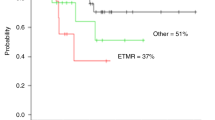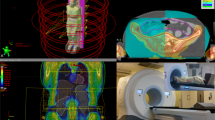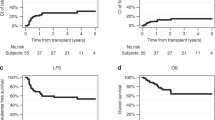Abstract
From June 1997 to August 2005, 52 consecutive newly diagnosed stage 4 neuroblastoma patients over 1 year of age were assigned to receive tandem high-dose chemotherapy and autologous stem cell rescue (HDCT/ASCR) as consolidation therapy. Fifty of the 52 patients underwent a first HDCT/ASCR and 44 patients underwent a second HDCT/ASCR. Eight patients (15.4%) died from treatment-related toxicity (seven during the second HDCT/ASCR). Total body irradiation (TBI) in the first HDCT/ASCR and a shorter interval (<12 weeks) between the first and second HDCT/ASCR were associated with a higher rate of treatment-related death in the second HDCT/ASCR (P=0.032 and 0.095, respectively). The tumor relapsed or progressed in 11 patients, and 33 patients remained event free with a median follow-up of 53 months (range 19–117) from diagnosis. The 5-year event-free survival (EFS) (±95% confidence interval) for all 52 patients was 62.1±13.7%. The application of TBI and local radiotherapy, and a longer interval between the first and second HDCT/ASCR were independently associated with a better EFS (P=0.026, 0.007 and 0.020, respectively). However, further studies will be needed to decrease the toxic death rate in the second HDCT/ASCR while reducing the relapse rate.
This is a preview of subscription content, access via your institution
Access options
Subscribe to this journal
Receive 12 print issues and online access
$259.00 per year
only $21.58 per issue
Buy this article
- Purchase on Springer Link
- Instant access to full article PDF
Prices may be subject to local taxes which are calculated during checkout



Similar content being viewed by others
References
Frappaz D, Michon J, Coze C, Berger C, Plouvier E, Lasset C et al. LMCE3 treatment strategy: results in 99 consecutively diagnosed stage 4 neuroblastomas in children older than 1 year at diagnosis. J Clin Oncol 2000; 18: 468–476.
Stram DO, Matthay KK, O'Leary M, Reynolds CP, Hasse GM, Atkinson JB et al. Consolidation chemoradiotherapy and autologous bone marrow transplantation versus continued chemotherapy for metastatic neuroblastoma: a report of two concurrent Children's Cancer Group studies. J Clin Oncol 1996; 14: 2417–2426.
Matthay KK, Villablanca JG, Seeger RC, Stram DO, Harris RE, Ramsay NK et al. Treatment of high-risk neuroblastoma with intensive chemotherapy, radiotherapy, autologous bone marrow transplantation, and 13-cis-retinoic acid. Children's Cancer Group. N Engl J Med 1999; 341: 1165–1173.
Ladenstein R, Philip T, Lasset C, Hartmann O, Garaventa A, Pinkerton R et al. Multivariate analysis of risk factors in stage 4 neuroblastoma patients over the age of one year treated with megatherapy and stem-cell transplantation: a report from the European Bone Marrow Transplantation Solid Tumor Registry. J Clin Oncol 1998; 16: 953–965.
Cohn SL, Moss TJ, Hoover M, Katzenstein HM, Haut PR, Morgan ER et al. Treatment of poor-risk neuroblastoma patients with high-dose chemotherapy and autologous peripheral stem cell rescue. Bone Marrow Transplant 1997; 20: 543–551.
Berthold F, Boos J, Burdach S, Erttmann R, Henze G, Hermann J et al. Myeloablative megatherapy with autologous stem-cell rescue versus oral maintenance chemotherapy as consolidation treatment in patients with high-risk neuroblastoma: a randomized controlled trial. Lancet Oncol 2005; 6: 649–658.
Philip T, Ladenstein R, Zucker JM, Pinkerton R, Bouffet E, Louis D et al. Double megatherapy and autologous bone marrow transplantation for advanced neuroblastoma: the LMCE2 study. Br J Cancer 1993; 67: 119–127.
George RE, Li S, Medeiros-Nancarrow C, Neuberg D, Marcus K, Shamberger RC et al. High-risk neuroblastoma treated with tandem autologous peripheral-blood stem cell-supported transplantation: long-term survival update. J Clin Oncol 2006; 24: 2891–2896.
Kletzel M, Katzenstein HM, Haut PR, Yu AL, Morgan E, Reynolds M et al. Treatment of high-risk neuroblastoma with triple-tandem high-dose therapy and stem-cell rescue: results of the Chicago Pilot II Study. J Clin Oncol 2002; 20: 2284–2292.
Brodeur GM, Pritchard J, Berthold F, Carlsen NL, Castel V, Castelberry RP et al. Revisions of the international criteria for neuroblastoma diagnosis, staging, and response to treatment. J Clin Oncol 1993; 11: 1466–1477.
Pession A, Prete A, Locatelli F, Pierinelli S, Pession AL, Maccario R et al. Immunotherapy with low-dose recombinant interleukin 2 after high-dose chemotherapy and autologous stem cell transplantation in neuroblastoma. Br J Cancer 1998; 78: 528–533.
Ifversen MR, Kaqedal B, Christensen LD, Rechnitzer C, Petersen BL, Heilmann C . Comparison of immunocytochemistry, real-time quantitative RT-PCR and flow cytometry for detection of minimal residual disease in neuroblastoma. Int J Oncol 2005; 27: 121–129.
Lamboov LH, Gidding CE, van den Heuvel LP, Hulsberqen-van de Kaa CA, Liqtenberg M, Bokkerink JP et al. Real-time analysis of tyrosine hydroxylase gene expression: a sensitive and semiquantitative marker for minimal residual disease detection of neuroblastoma. Clin Cancer Res 2003; 9: 812–819.
Seeger RC, Reynolds CP, Gallego R, Stram DO, Gerbing RB, Matthay KK . Quantitative tumor cell content of bone marrow and blood as a predictor of outcome in stage IV neuroblastoma: a Children's Cancer Group Study. J Clin Oncol 2000; 18: 4067–4076.
Tchirkov A, Kanold J, Giollant M, Halle-Haus P, Berger M, Rapatel C et al. Molecular monitoring of tumor cell contamination in leukapheresis products from stage IV neuroblastoma patients before and after positive CD34 selection. Med Pediatr Oncol 1998; 30: 228–232.
Tsang KS, Li CK, Tsoi WC, Leung Y, Shing MM, Chik KW et al. Detection of micrometastasis of neuroblastoma to bone marrow and tumor dissemination to hematopoietic autografts using flow cytometry and reverse transcriptase-polymerase chain reaction. Cancer 2003; 97: 2887–2897.
Burchill SA, Kinsey SE, Picton S, Roberts P, Pinkerton CR, Selby P et al. Minimal residual disease at the time of peripheral blood stem cell harvest in patients with advanced neuroblastoma. Med Pediatr Oncol 2001; 36: 213–219.
Rill DR, Santana VM, Roberts WM, Nilson T, Bowman LC, Krance RA et al. Direct demonstration that autologous bone marrow transplantation for solid tumors can return a multiplicity of tumorigenic cells. Blood 1994; 84: 380–383.
Flandin I, Hartmann O, Michon J, Pinkerton R, Coze C, Stephan JL et al. Impact of TBI on late effects in children treated by megatherapy for Stage IV neuroblastoma. A study of the French Society of Pediatric oncology. Int J Radiat Oncol Biol Phys 2006; 64: 1424–1431.
Meacham LR, Gurney JG, Mertens AC, Ness KK, Sklar CA, Robison LL et al. Body mass index in long-term adult survivors of childhood cancer: a report of the Childhood Cancer Survivor Study. Cancer 2005; 103: 1730–1739.
Ladenstein R, Lasset C, Philip T . Treatment duration before bone marrow transplantation in stage IV neuroblastoma. European Bone Marrow Transplant Group Solid Tumour Registry. Lancet 1992; 340: 916–917 (letter).
Kushner BH, Kramer K, LaQuaglia MP, Modak S, Yataghene K, Cheung N-KV . Reduction from seven to five cycles of intensive induction chemotherapy in children with high-risk neuroblastoma. J Clin Oncol 2004; 22: 4888–4892.
Acknowledgements
We thank the residents and nurses who cared for the patients, and without whom this study would not have been possible.
Author information
Authors and Affiliations
Corresponding author
Rights and permissions
About this article
Cite this article
Sung, K., Lee, S., Yoo, K. et al. Tandem high-dose chemotherapy and autologous stem cell rescue in patients over 1 year of age with stage 4 neuroblastoma. Bone Marrow Transplant 40, 37–45 (2007). https://doi.org/10.1038/sj.bmt.1705691
Received:
Revised:
Accepted:
Published:
Issue Date:
DOI: https://doi.org/10.1038/sj.bmt.1705691
Keywords
This article is cited by
-
Incorporation of high-dose 131I-metaiodobenzylguanidine treatment into tandem high-dose chemotherapy and autologous stem cell transplantation for high-risk neuroblastoma: results of the SMC NB-2009 study
Journal of Hematology & Oncology (2017)
-
Toxicity of tandem high-dose chemotherapy and autologous stem cell transplantation using carboplatin-thiotepa-etoposide and cyclophosphamide-melphalan regimens for malignant brain tumors in children and young adults
Journal of Neuro-Oncology (2014)
-
Tandem high-dose chemotherapy and autologous stem cell transplantation in patients with high-risk neuroblastoma: Results of SMC NB-2004 study
Bone Marrow Transplantation (2013)
-
Autologous cord blood transplantation in a child with stage 4 neuroblastoma
Bone Marrow Transplantation (2013)
-
Myeloablative chemotherapy and autologous stem cell transplantation in patients with relapsed or progressed central nervous system germ cell tumors: results of Korean Society of Pediatric Neuro-Oncology (KSPNO) S-053 study
Journal of Neuro-Oncology (2013)



